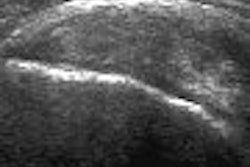
Sonography is as accurate as palpation-guided fine-needle aspiration (FNA) in evaluating palpable breast lesions, according to research published in the October issue of the Journal of Ultrasound in Medicine.
"Sonography can replace palpation-guided FNA for diagnosis of palpable lesions of the breast when the BI-RADS sonographic final assessment system is used appropriately," wrote a research team led by Dr. Jin-Young Kwak of the Yonsei University College of Medicine in Seoul, South Korea.
To evaluate the utility of the American College of Radiology's Breast Imaging Reporting and Data System (BI-RADS) sonographic final assessment approach and palpation-guided FNA in this application, the researchers used a computerized database to identify 160 palpable breast lesions that had received palpation-guided FNA, targeted sonography, and pathologic confirmation between May 1, 2002, and October 1, 2004. All lesions ranged in size from 6 to 65 mm, with a mean of 23.3 mm (JUM, October 2006, Vol. 25:10, pp. 1256-1261).
Each of the patients were evaluated using an HDI 3000 or HDI 5000 ultrasound scanner (Philips Medical Systems, Andover, MA), with each lesion classified according to BI-RADS sonographic protocol. FNA results were assigned to one of five categories: benign, having atypical cells, suspicious for malignancy, malignancy, and insufficiency.
The rates for sensitivity, specificity, accuracy, positive predictive value (PPV), and negative predictive value (NPV) for sonography and FNA are shown below.
|
"Although in some combined FNA results, specificity, accuracy, and PPV were superior to those of sonography, it is impossible to adjust these complex FNA results in practical patient care," the researchers wrote. "Also, in the objective of not missing malignancy, sensitivity and NPV are most important. Our study revealed no statistical differences between FNA and sonography for sensitivity and NPV (p > 0.05)."
When cytologic results revealed insufficiency, atypical cells, and suspicion of malignancy, sonographic categorization provided good guidance for managing palpable abnormalities, according to the authors. When FNA findings characterized the palpable abnormality as having atypical cells or being suspicious for malignancy on FNA, 10 (90.9%) of 11 cancers were classified as category 4 on sonography.
Of the 18 cases in which FNA results were reported as atypical cells or suspicion of malignancy, seven had benign conditions. Five of these seven cases (71.4%) were classified as category 1 or 3 on sonography, indicating the possibility of false-positive cytologic results, according to the researchers.
When the palpable abnormality showed insufficient results on FNA, both of the two cancers were classified as category 4 on sonography.
The authors acknowledged a number of limitations in the study, including an insufficient period of imaging follow-up in some cases. The study was also based on examination of the data by breast imaging specialists and may not be reproducible in other institutions, they stated. In addition, further investigation with a larger dataset is needed.
The group also noted that the BI-RADS sonographic final assessment system produced findings similar to FNA, except for some combined FNA applications. In addition, FNA results can be difficult, especially when the result is insufficiency and atypical cells. Moreover, FNA is invasive and overlaps other procedures, according to the researchers.
"Therefore, we conclude that sonography can replace palpation-guided FNA for diagnosis of palpable lesions of the breast when sonographic examinations are done meticulously," the authors wrote.
By Erik L. Ridley
AuntMinnie.com staff writer
October 10, 2006
Related Reading
Mammo cures cancer! Debunking popular breast cancer myths, October 3, 2006
Streaming US, elastography US give clearer picture of breast lesions, June 16, 2006
Breast surgeon expresses reservations about screening US, May 13, 2006
Expanded role looms for 3D in breast imaging, May 11, 2006
Auto breast US handily spots lesions in early study, January 13, 2006
Copyright © 2006 AuntMinnie.com




















